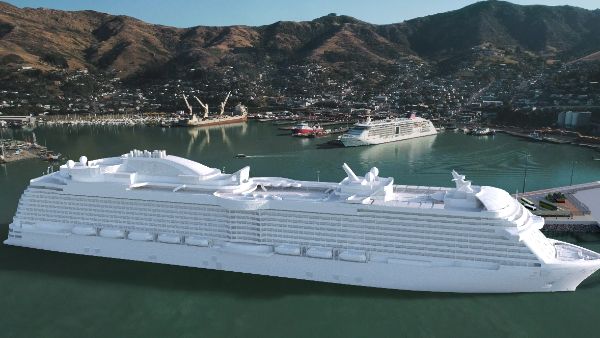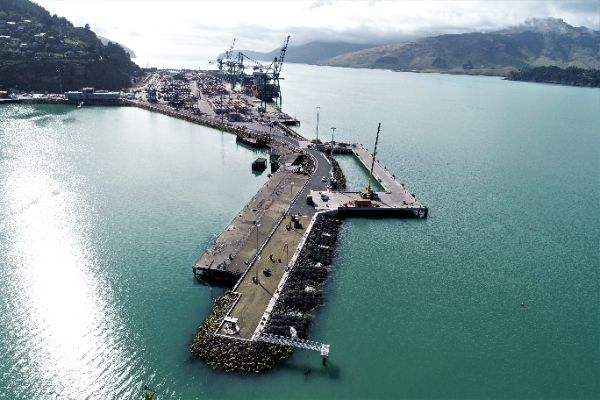Lyttelton Port’s Cruise Berth Officially Opened
New Zealand’s first purpose-built cruise ship facility will be officially opened by the Mayor of Christchurch Hon. Lianne Dalziel today, signifying Lyttelton Port Company’s commitment to building infrastructure to support the city’s future.

While COVID-19 border restrictions have impacted the 2020/21 cruise season, the berth’s completion is a significant milestone worth celebrating, says Lyttelton Port Company’s (LPC) Chief Executive Officer Roger Gray.
“The Cruise Berth has been delivered on-time and on budget, despite the challenges of COVID-19. This will be a fantastic long-term asset for Christchurch and Canterbury,” says Roger.
Since 2018, a dedicated team of contractors, project managers and engineers have worked tirelessly to build the cruise berth.

A redesign of the berth in the early stages of the project has minimised the number and size of piles in the wharf and significantly reduced underwater noise which can affect marine mammals – notably Hector’s Dolphins which are endemic to the South Island.
“The project raised the standard of practice in protecting marine mammals in construction projects in New Zealand by designing with nature in mind,” says Roger.
The redesign of the wharf structure also presented LPC an opportunity to significantly reduce the embodied carbon emissions of the wharf by adopting a design that reduced steel and concrete use.
Overall, from the initial concept design we were able to achieve a design that resulted in close to a 50% reduction in embodied carbon emissions associated with the main materials of concrete and steel used in the construction of the berth.
“As a major player in Whakaraupō/Lyttelton Harbour we know we have a responsibility to not only protect our marine environment but also play our part in contributing to addressing climate change,” says Roger.
While the COVID-19 Alert Level 4 lockdown in March did halt work on the project, the berth has been completed on time and on budget – quite an achievement in a year which has been plagued by construction delays across the globe, says Roger.
Large cruise vessels have been unable to berth since the February 2011 earthquake. With the new cruise berth in place, LPC will be able to welcome the full range of cruise vessels, including ships that cater for 6,000 passengers and 2,000 staff.
While more than 70 bookings for cruise ships have been received for the 2020/21 season, due to current border restrictions it is unlikely these vessels will visit Lyttelton this summer.
LPC remains positive about the berth’s future as a long-term asset for Lyttelton Port.
“Last week, we welcomed Heritage Expeditions' flagship vessel Spirit of Enderby to the berth, which has been granted an exemption by the government to operate domestic expedition cruises in New Zealand this season.”
LPC is also exploring opportunities to use the berth for other inner harbour operations, including using the space for fishing vessels, Antarctic research vessels and some bulk cargo operations.
“The berth is an asset for LPC, and will free up much needed capacity in our inner harbour. While we are disappointed this cruise season will be impacted by the COVID-19 pandemic, we will be ready to welcome cruise ships when they do return,” says Roger.
"LPC remain focused on creating a profitable and sustainable port across all our bulk cargo and container operations - for both our shareholder and the people of Canterbury.”
About LPC's cruise berth:
Specifications:
The cruise berth is located on the eastern side of Lyttelton’s inner harbour entrance.
It measures 148 metres long and 10 metres wide. The berth can cater for cruise vessels up to 362 metres, such as MS Oasis of the Seas which carries 6,000 passengers and 2,000 crew.
The landside amenities include bus shelters and a small building with bathrooms for passengers.
The berth is designed to the latest seismic design code, ensuring safe mooring for vessels in Lyttelton’s wind and wave conditions.
The berth cost approximately $67 million to build and was completed on time and budget.
Biodiversity Positive:
As part of LPC’s Sustainability Strategy we have an ambition to contribute positively to harbour biodiversity.
The wharf is a piled structure which meant a significant period of pile driving was needed to construct the wharf. Pile driving results in underwater noise that can be harmful to marine life. In Lyttelton Harbour we have Hector’s dolphins - the world’s smallest marine dolphins.
A redesign of the berth in the early stages of the project minimised the number and size of piles in the wharf, which in turn significantly reduced underwater noise that can affect marine mammals.
The project raised the standard of practice in protecting marine mammals in construction projects in New Zealand by designing with nature in mind – see our Marine Mammal Management Plan for more information.
We also instituted a very protective way of operating during construction where a fulltime marine mammal observer (a dolphin spotter) was in place during the works which stopped anytime an animal was in the zone closest to the pile driving.
A significant research programme was also generated from the project where Styles Group and Cawthron Institute worked together to understand how Hector’s dolphins respond to underwater noise from construction.The final report is due early in 2021.
Carbon-sensitive design:
As part of LPC’s Sustainability Strategy, we have ambitious targets around carbon emissions reduction, and we look for opportunities to reduce our footprint in both operations and development.
The redesign of the wharf structure also presented LPC an opportunity to significantly reduce the embodied carbon emissions of the wharf by adopting a design that minimised steel and concrete use.
Embodied carbon refers to the carbon emissions resulting from the production of materials used in the construction of infrastructure, as well as those from the construction process itself. Infrastructure decision-makers have control over these emissions through choices made in the planning, siting, designing and procurement stages of a project.
We had an opportunity to aim for a reduction of embodied carbon across the wharf development, which we tackled in the planning and design phase by ensuring the design minimised use of carbon-heavy construction materials such as steel and concrete.
Overall, from the initial concept design, we were able to achieve a design that resulted in close to a 50% reduction in embodied carbon emissions associated with the main materials of concrete and steel. Other aspects of the project were approached with sustainability in mind ie use of rock bags, materials transportation, recycling of materials ie pile casings and concrete.
Cruise berth a symbol of earthquake recovery at LPC
The completion of the cruise berth coincides with the end of major construction at Lyttelton Port and the completion of the Lyttelton Port Recovery Plan following the 2010 / 2011 Christchurch earthquakes.
Lyttelton Port experienced significant damage following the earthquakes, and over the last nine years LPC has worked tirelessly to repair Port infrastructure and build a Port for the future.
This work has seen the completion of a group of significant construction projects this year:
- The completion of the first two stages of the Te Awaparahi Bay reclamation project, creating approximately 15 new hectares of new land. A section of this new land will be primarily used to support the vehicle import trade with the option to use it to expand the Lyttelton Container Terminal in the future.
- Vital strengthening and repair work to LPC’s oil berth, fueling Canterbury and the South Island with essential petrol, LPG and fuel products and futureproofing the berth for our region.
- Four purpose-built reefer towers to support the refrigerated import and export markets.
- Realigned back road and additional rail siding at the Lyttelton Container Terminal to increase LPC’s rail capacity.
- The Lyttelton lighthouse was returned to its rightful home as part of the cruise berth project. Built in 1878, the lighthouse is a historic piece of infrastructure which was removed from Z Berth after the earthquakes because of significant damage to the wharf structure beneath it.


 NIWA: Flooding From Underneath - New Tool Reveals Shallow Groundwater Elevations
NIWA: Flooding From Underneath - New Tool Reveals Shallow Groundwater Elevations Commerce Commission: Commission Concludes Auckland Airport Over-charging By $190 Million
Commerce Commission: Commission Concludes Auckland Airport Over-charging By $190 Million The Future Is Rail: Ferry Decision - Common Sense Prevails
The Future Is Rail: Ferry Decision - Common Sense Prevails Aotearoa Food Rescue Alliance: Grocery Market Reform Must Include Mandatory Food Rescue Partnerships
Aotearoa Food Rescue Alliance: Grocery Market Reform Must Include Mandatory Food Rescue Partnerships Hugh Grant: Zero Trust Security - A Buzzword Or The Ultimate Protection?
Hugh Grant: Zero Trust Security - A Buzzword Or The Ultimate Protection? Bill Bennett: Comcom revisits fibre rules as competition intensifies
Bill Bennett: Comcom revisits fibre rules as competition intensifies



